- Classified ads
- Last magazine
- Technical Specifications
- Legal notices
- Website map
- Classified ad

NINJA 8 (SOLD)
- +33 6 88 09 46 68
- www.multicoquesconsulting.com
- Lying LE HAVRE, France
Practical Information
- Technical specification
- Test : Ninja 8
- Finance your Ninja 8
- Insure your Ninja 8
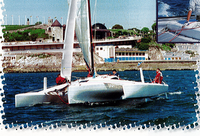
Description
Designer: Jean Louis LIGONNET Architect: Gérard CHENUS Builder: Darren NEWTON Shipyard: DAZCAT Year built: 1997 Flag of registry: France Length o.a.: 8,65 m Water length: 7,95 m Beam o.a.: 6,60 m Drought min. – max.: 0,45 – 1,40 m Air draught: 13 m Displacement: 1 300 kg (weighed in September 2020) Conception Sandwich composite hulls under vacuum: 420 g biaxial glass fibre/polyester & Airex foam, local reinforcements with carbon fabrics in strain areas such as the central crossbeam, daggerboards and rudders. Main hull: Crash box and waterproof volume in the forward cabin, composite frame under the roof (reinforcement of the foot of the mast), monolithic area under the deck in the forward cabin (reinforcement of the central crossbeam) Amas: Crash box and waterproof volume in front of the fasteners of the central crossbeam, watertight bulkhead in front of the daggerboards casings and demountable partition in front of the rudders, monolithic zones under the deck with darning of fibre composite laminates on the shell plating (reinforcement of the crossbeams), daggerboard casings in composite sandwich, laminated on the hull bottom and on the deck, inside carbon reinforcements at the fasteners of the rudders, Lewmar hatches for storage access. Antifouling coppercoat (2017) Self-draining cockpit with open sugar scoop Carbon fibre rotating wing mast with ball and socket joint, one pair of spreaders Carbon fibre boom with rotating arm Curved central crossbeam in carbon composite Straight rear crossbeam in anodised aluminium alloy Asymmetric daggerboards, implemented in the amas, operated from the cockpit Two shaped composite rudder blades, sliding into castings Three helms: amas (hand steering gear with stanchions, back supports and compass) and cockpit (stick) Anchoring: Spade A80 with 5 m mooring chain 10 mm + 35 m leaded rope 12 mm Trampolines (sewing 2020), safety nets (2020) Manual bilge pump Through hull echo sounder and speedo Deck equipment 2 MEISSNER 21ST-32 deck Winches and 1 MEISSNER 23ST-41 winch in the cockpit (cleaned and lubricated in 2020) 8 LEWMAR rope clutches (deck and mast), blocks RONSTAN/HARKEN 2 stainless steel mooring cleats rétractables on the amas and 2 stainless steel cleats at the bow Aluminium bowsprit with NEX 1.5 Furlassist Cockpit compass 2 Helm compasses Silva 85 Magnetic North Draped cable life lines on both sides of the main hull Sails Carbon membrane full-batten gaff main sail with 3 reefs (UK Sails 2008) Kevlar membrane PROFURL furling headsail (UK Sails 2008) Code 0 (44 m2) « Dimension Polyant » (Incidence 2020) Asymmetricalspinnaker (71 m2) « Nylon croisière Coupe Tri-radiale » (Incidence 2020) Symmetrical Nylon spinnaker (79 m2) Lazy bag, jib sleeve (2020 et 2018) Electronics B&G Vulcan XSE7 chartplotter Navionics 46XG mapping 2 B&G Triton 2 cockpit digital display VHF AIS Radio Ocean RO6800 FURUNO GPS Navigator EPIRB Ocean Signal E100 Comfort Bedding for 3/5 persons: front double berth (with deck hatch) 2,05 x 1,55/0,60, 2 king-size saloon berth, 1 rear berth under cockpit 1,95 x 0,70 Headroom (galley, navigation): 1,95 Sunbrella washable cotton upholstery (2018) 2-burner gas stove SMEV (outdoor gas cylinder, indoor shutoff valve), stainless steel kitchen sink (50 L water tank) with electric water pump, coll space under the saloon table Electricity: Solbian 64 W flexible solar panel (2018), Western Marine regulator, 12 V Stormline 115 Ahbattery (2018), 4 Led spotlights, navigation lights at the masthead, 3 USB ports Jabsco manual marine toilets Engine Yamaha 8 HP 2 stroke long shaft outboard (exhaust pipe and all gaskets including cylinder head 2019) Wooden motor bracket, articulated, on travelling rails fixed on the bottom of the cockpit with stainless steel axes lock (the engine slides under the floor of the cockpit for weight centering) Offshore security: EU category C Autobraking road trailer (Ninja is transportable disassembled)
Information
Accommodation, contact the seller.
Share this advert
You may also be interested in.

TRIMARAN REPLIABLE MATTIA T11 (sale postponed)

TRIMARAN IRENS 40

NEEL TRIMARANS 52, delivery possible May 2025

NEEL 45 available south France

DRAGONFLY 920 EXTREME
TRIMARAN FOILER EX TRINITRINE

FREELY EVOLUTION (SOLD)

TRIMARAN A CAPELLA 40'
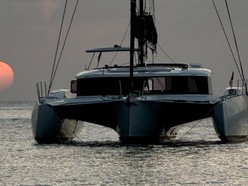
Neel 47 for sale

TRIMARAN MULTI 23

TRIMARAN POLYNESIE 42'
Add to favorites.
You added " " to your favorites.
You have deleted " " de vos favoris.
- Skip to navigation (Press Enter)
- Skip to main content (Press Enter)
NINJA PRO is a fast tacking proa. The original design with one main hull and one outrigger hull comes from Polynesia. The modern and innovative designed Ninja version has a big advantage compared to her historical parent: It tacks like a sailing dinghy!
The Carbon mast is fitted on the main hull and there is only one ruder and dagger board needed. Therefore the Ninja proa can be build lighter and has the advantages of lighter weigt and easier tacking performance compared to sport catamarans.
Further FEATURES are:
- Ninja has no boom and provides more safety during sailing and jibeing,
- Ninja PRO can be upgraded to a trimaran,
- Ninja fits into a practical box with measurements of 4.7x0.80x0.85m
NINJA PRO is available equipped as:
- NINJA PRO standard
- NINJA PRO plus
NINJA SPIDER
NINJA SPIDER is a very modern designed trimaran. With its chines on the hulls and relatively wide beams has the Ninja Spider similarity with a smaller version of the 2010 Americas Cup winner BMW Oracle. The big advantage of the Ninja SPIDER compared to the Ninja PRO is the well balanced stability given with the second outrigger hull. Sailed singlehanded the Ninja SPIDER is a very fast sports multihull. Sailed with 2 persons or with a few kids it is the perfect fun boat for the whole family.
The Ninja SPIDER fits like the Ninja PRO in the practical box in the same dimensions of 4.7x0.80x0.85m. The trimaran can get upgraded to a proa (Upgrade: Proa beams und trampolines necessary)
Ninja SPIDER is available equipped as:
- NINJA SPIDER resort Trimaran ready to sail, Dacron sails with jib on roller furler extra protected bow sections sail surface 11.4m2
- NINJA SPIDER plus Trimaran ready to sail, North Sail sails with Carbon bow sprit and screecher sail surface 21.4m2
- NINJA SPIDER R Trimaran ready to sail, North Sails sails with Carbon bow sprit and screecher 2 color gel coat, Ronstan racing hardware extra Carbon reinforcing in beams telescopic tiller arm extention sail surface 21.4m2
Alternatively,
- Register with Facebook
- Register with Google
Why Boatshed?
View all of your boats statistics in real time
Create a virtual "watch" on boats you're interested in
Refer a boat and earn up to 20% of the brokers commission
Language & Currency
Search our catalog, go direct, enter a boat reference, ninja 8 fast trimaran, with great space below, £ 0 sold / unavailable.
- Boat REF# · 224204
- Length · 8.00m
- Year · 1997
- Construction · GRP
- Underwater profile · Multihull
- Sleeping berths · 5
- Engine · 1 x gasoline 8hp, Yamaha ()
- Lying · Falmouth

Boatshed Cornwall
This boat is off the market but here are some boats that are still for sale.
- Specification
- Additional Information
Extra Details
| Designer | Jean Louis Ligonment | Builder | Multimarine | Lying | Falmouth |
|---|
| Engine | 1 x gasoline 8hp | Engine make and model | Yamaha () | Engine Hours | Not Recorded | Engine Cooled | Direct | Steering | tiller | Drive | outboard | Fuel consumption (approx) | Not Recorded |
|---|
| Length | 8.00m | LWL | 7.94m | Beam | 5.50m | Draft Min | 0.60m | Draft Max | 1.80m | Displacement | 1,600kg (3,528.0lbs) | Headroom | 2.00m | Storage | On mooring |
|---|
Other rigged Naastrom Carbon Fibre spars (1997) with Stainless Steel standing rigging ()
| Reefing mainsail | UK Sails - Slab (2007) Stack Pack, Fully Battened, Lazy Jacks, 3 Reefs | Headsail | UK Sails - Furling (2007) | Other sails | Asymmetric (1997) | Screecher (1997) | Spare Main 1 (1997) | Spare Main 2 (1997) | Self Tacking Jib (1997) |
|---|
| Spinnaker gear |
|---|
Electrical Systems
12 volt battery, 1 batteries charged by: solar panels
Construction
| Construction | GRP | Underwater profile | Multihull | Finish | Gelcoat finish |
|---|
Accommodation
| Total # of berths | 5 | No. of double berths | 2 | No. of single berths | 1 | Cabin(s) | 1 | Heads | 1 heads (Manual) |
|---|
2 burner propane Stove
| Stove | Sink | Manual water system | Non-Smokers |
|---|
| Sail cover | Fenders | Instrument Covers |
|---|
3 sheet winches 1 anchors (Danforth)
Nav Equipment
| Compass | Log | VHF | Chart plotter | Navtex | Navigation lights | Depth sounder |
|---|
Safety Equipment
| Life buoys |
|---|
1 bilge pumps (1 manual / 0 electric)
Broker's Comments
The Ninja 8m is a fast production built trimaran, suitable for racing and or cruising. Below she has a surprising amount of space sleeping 5 in comfort with a small galley and a heads which is located neatly behind the companion way
Above decks she is an out and out speed machine with Carbon spars and high performance sail plan. Safety is assured by the wide trampolines that extend right up to the bows.
When necessary she is powered by an 8 HP outboard which stows under the cockpit and is deployed into its drive position with a clever pully system.
Overall she is In good condition and has only had light use since new she is all ready to sail - so why not come and view.
These boat details are subject to contract. Note: Offers on the asking price may be considered.
Get Access to More
View unlimited photos of every boat
Walkthrough videos
VR 720° experiences
Get notified of new boats of your interest
Personalised boat recommendations
Save boats to 'My Boatshed'
Cost Of Ownership
Yachting Monthly
- Digital edition

Wow, that was fast! Why trimarans are SO much fun to sail – and how to do it
- Theo Stocker
- February 13, 2024
For their size, trimarans can punch well above their weight in speed, cruising potential and fun. Monohull sailor Theo Stocker gets to grips with how to handle one
Humans tend to gravitate into tribes of like-minded enthusiasts, enjoying the encouragement, support and sense of identity, while often looking askance at others; sailors at motorboaters, cruising sailors at racers, monohull sailors at raft, I mean, multihull sailors, and everyone looks askance at jet-skiers.
Large cruising catamarans (40ft now counts as a small one) are a world apart from monohull sailing, but there’s a sub-tribe of sailors dedicated to life on three hulls and builders such as Dragonfly, Corsair, Farrier, and Astus give them plenty of choice.
I’ve been sailing a 22ft (7m) Astus 22.5 this season, with just enough space for a family of four and a minimum of creature comforts. Thanks to her VPLP-designed hulls and 650kg all-up weight, we can sail upwind at 7-plus knots and downwind at over 10 knots with ease, all on a roughly even keel, while the kids play Duplo down below. It can also be beached and is towable behind a car.
Having, it seems, caught the trimaran bug, I wanted to get better at sailing and handling the boat, but my monohull sailing experience and habits were proving something of a hindrance, so we sought advice from some existing trimaran owners, and well as the UK’s top multihull sailors.
Much of the advice will apply to all multihulls , whether two or three-hulled, while other parts are just for small trimarans. I also found that brushing-up some of my rusty dinghy sailing skills helped get my head around what we were trying to do.
To try out our expert tips we went out sailing to see what difference they made. On the day, we got a solid Force 4-5 southwesterly, averaging 16 knots, but fluctuating between 12 and 20 knots true.
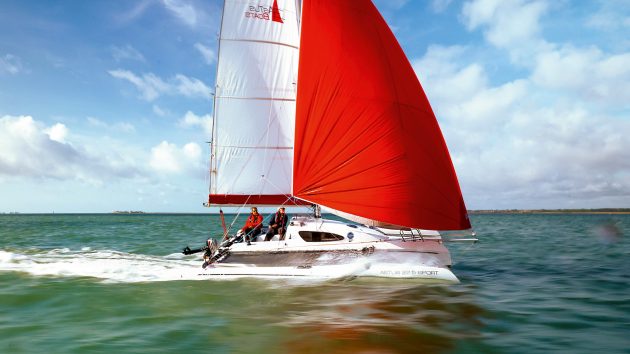
Blasting about on a sporty trimaran is a whole world of fun, but is much calmer than it looks
Trimaran sail trim
One of the biggest differences between a cruising monohull and a multihull is how the mainsail is trimmed. Leech tension on a yacht is often largely controlled by the kicker and the backstay, while the mainsheet sheets the mainsail in and out, predominantly controlling the angle of the boom to the centreline, and there may be a short traveller.
On a mulithull, however, there’s more than enough space for a good, wide traveller. Those who sail on performance monohulls will also be used to this. The sail shape is mainly controlled by the mainsheet, and the traveller then moves the boom towards or away from the centreline.
This is exaggerated on a multihull which has wide shrouds, swept well aft with no backstay, making space for a powerful square-top mainsail with full-length battens. There’s no backstay to bend the mast and flatten what is anyway a pretty rigid mainsail.
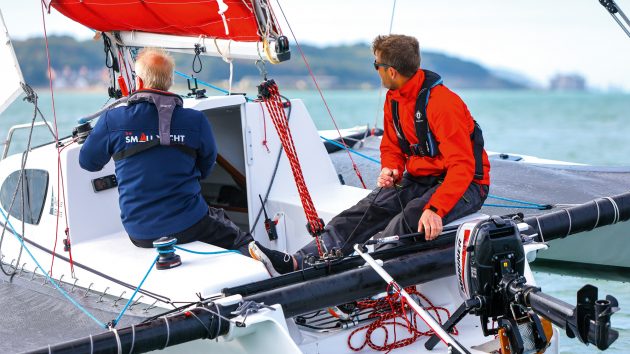
The mainsheet purchase creates enough power to control the leech of the square-top mainsail
Depowering a trimaran
Sailing on a monohull, heel and weatherhelm and eventually a broach give loads of warning that you’re pushing too hard. With straight hulls and little heel, those warning signs don’t really apply to multihulls.
In reality, however, there are a host of warning signals that it’s time to back-off; they’re just a bit different. Even then, there’s still a large safety margin before you get close to danger.
By way of reassurance, with the boat powered up on a beat, Hein, from Boats on Wheels, the boat’s owner, stood on the leeward hull and lent on the shrouds. Even as his feet got wet and the wind gusted at the top of Force 4, the boat didn’t bat an eyelid, thanks to the huge buoyancy of the floats.
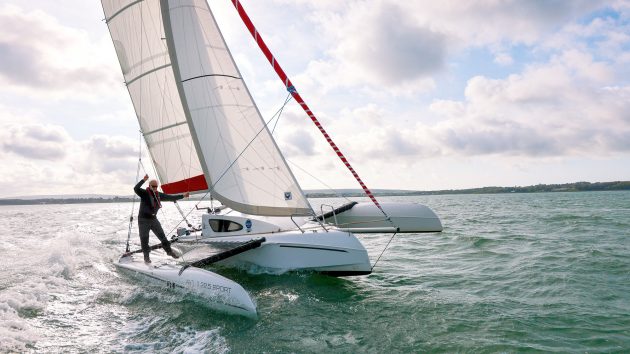
Even with a person on the leeward float the boat was extremely stable
On the water – sail trim
My first inclination was to point the boat as high upwind as possible, pin the sails in and go for height. Doing that resulted in a not-terrible boat speed of 5-6 knots and a good pointing angle.
Free off by a handful of degrees however, and ease the sails just a smidge, and the speed leapt up to 8-9 knots – over 50% more; a huge increase. So, don’t pinch. If you had a decent chartplotter on board, you could find your optimum speed to angle using velocity made good (VMG).
I was also tempted to pinch in the gusts, but it’s better to hold your course and let the speed increase until the main needs easing.
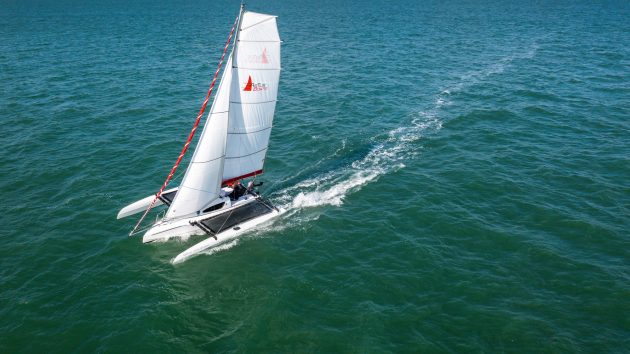
On the wind, it’s time to get the boat fully powered up
If that’s the case, drop the main down the traveller an inch or two or ease some twist into the mainsail and it makes all the difference in the world, but not so far that the top battens fall away and invert – that really isn’t fast. Push too hard and the boat will slow down, largely from the drag of submerging the leeward float and crossbeams. If you’re still overpowered and the main is luffing, it’s time to reef. Downwind is different, but we’ll get onto that later.
After we put a reef in the main, our boat speeds upwind remained largely the same, and the boat was much happier. I came away feeling reassured that even a little trimaran like this would be pretty difficult to capsize, and there were always plenty of warning signs telling me to take my foot off the pedal a little.
Article continues below…

Catamaran sailing skills: Mooring and anchoring a multihull
How do you make an average passage speed of 7 knots, fit in three double cabins and a huge saloon…

Monohull or multihull: which is best for blue water?
As former editor of Yachting World, David Glenn has plenty of experience of both monohull and multihull cruising. Here he…
Tacking and gybing a trimaran
Everyone knows that multihulls don’t tack as well as monohulls. Straight hulls and wide beam don’t lend themselves to turning, especially when coupled with the displacement and fixed keels of big cats. Trimarans are a little easier, with a single central daggerboard to act as a pivot, and one or other of the floats will generally be clear of the water. On the downside, light displacement means that there isn’t much momentum to keep you going through the turn and plenty of windage to stop you.
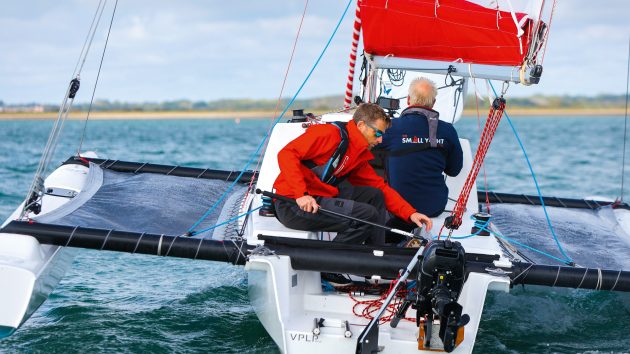
On a trimaran the central daggerboard helps the boat to turn by providing a central pivot point that catamarans lack
Speed is your friend. Build speed up before the tack to give you as much momentum as possible. The helm needs to steer positively into and through the turn, and if necessary, keep the jib backed on the new windward side to help the bow through the wind. Don’t worry about scrubbing speed off, but you don’t want to get stuck in irons.
When it comes to gybing, speed is again key. The turning bit isn’t going to be an issue as you’ll be scooting along, but the faster you’re going, the less load there will be on the sails. The more you slow down, the more the true wind will pile up.
Trimaran sailing skills
Tacks took a bit of practice. It felt plain wrong to jab the tiller across the boat, slamming a big break on in the water but I ended up putting us through the tacks far too slowly, losing a lot of speed. A more aggressive approach worked better. On the Astus, the traveller was between me and the tiller, so the tiller extension needed to be swung around the stern behind the mainsheet onto the new side.
Similarly, old habits of controlling a gybe needed to be modified. With the asymmetric set, we were planing at well over 10 knots, and the ideal is to stay on the plane. Heading dead downwind and centring the main lead to a more violent manoeuvre than flying into the gybe as fast as possible and, as the boom was never that far out thanks to the apparent wind angle, it didn’t need much extra controlling.
Coming up onto the wind after the gybe helped the asymmetric around the front of the jib and to fill on the new side. Stay too deep and it’ll get blanketed by the main. Once we had built up some apparent wind, we could bear away again.
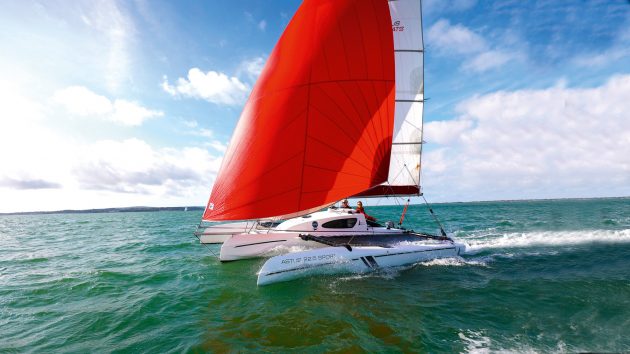
You’ll be on a course deep downwind before you know it, hitting speeds in the double digits
Downwind in a trimaran
Upwind cruising may be fun in a multihull, but bearing away and going with the wind is what it’s all about. Easily-driven hulls, a generous sailplan and light weight mean you can be up and planing, leaving displacement boats wallowing in your wake.
The big difference comes from apparent wind. If you’re in a boat that can do 15 knots downwind in 20 knots of true wind, the resulting wind angles can really mess with your head.
To get going then, says Brian Thompson, ‘Use those leech tell-tales again when sailing downwind and reaching to set the correct twist through the mainsheet, and use the traveller to set the correct angle of the whole sail to the wind.’
As the wind and your speed builds, bear away and trim the main accordingly.
In theory, you shouldn’t need to ease the traveller at all, but you may need to if you want to sail deep downwind. As the gust fades, you’ll find the boat slows down, so you can come back up towards the wind a little to pick up some more breeze, and then bear away as you accelerate again.

Bear away as the boat accelerates. Your course will be something of a slalom as you look to keep a consistent wind angle
This results in something of a ‘slalom’ course, and will also be accentuated if you’re sailing down waves, but that’s all quite normal for apparent wind sailing. Ultimately, you’re looking for a consistent apparent wind angle, even if the resulting wake isn’t straight.
It’s worth remembering that apparent wind reduces the felt effect of the wind, so you need a sailplan to suit the true, not apparent wind speed.
I found that the boat was more sensitive to having a balanced sailplan and trim downwind than upwind, largely because you’ve got almost double the canvas up, with the bowsprit as an extra lever. When weather helm built, I needed to ease the mainsheet to increase twist to depower so that I could bear away. I must admit, getting the boat balanced, sailing fast and light on the helm at 15 knots was something I came away feeling I needed more practice at.
Reviewing the images, I suspect the asymmetric was sheeted in too hard, with too much twist in the main.
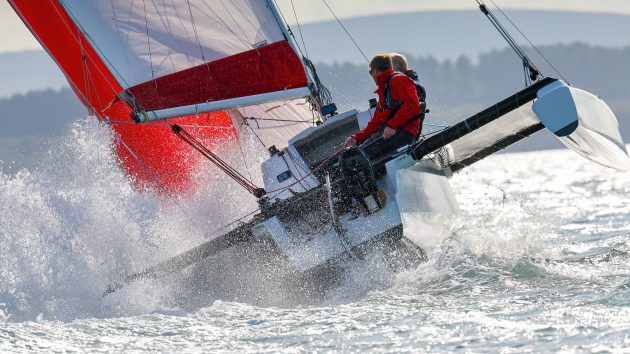
Getting a float fully submerged is when it’s time to back off
On the water
Unfurling the gennaker worked best on a beam reach, giving plenty of airflow over the sail to help it fully unfurl. This was also roughly the fastest point of sail, ideal for getting up some speed for apparent wind sailing. We mostly had the sails set for a close reach, even when we were beyond 120º off the true wind on a broad reach.
It was possible to soak deeper downwind, but lose the apparent wind benefit downwind and our speed dropped off dramatically, prompting us to point a bit higher to find some more speed.
As the boat powered up, it paid to hold a slightly higher angle than I would have done in a monohull for the boat to properly take off and get up into double digit speeds – topping out at 15 knots. Lymington to Cowes would have taken us just half an hour at that speed. It’s easy to give yourself a heck of a beat back!
We were sailing on a pretty flat day, so didn’t have to contend with any waves to speak of. On the recent RTI this is what caused the capsizes of at least two multis, a sobering reminder that you need to sail much more conservatively in lumpier conditions.
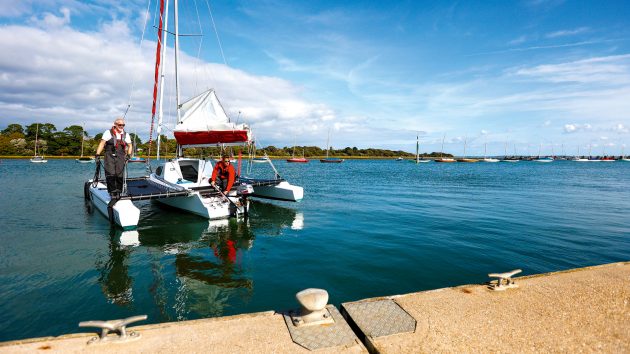
The bows want to point downwind, so a stern-first approach works with rather than against the boat
Coming alongside
A 650kg boat with no draught and plenty of windage feels dreadfully skittish when manoeuvring in confined spaces. Straight hulls with no forgiving curves and fragile-looking sharp bows make berthing tricky. You’ve got a couple of advantages on your side, however. In the Astus, the floats are at pontoon height making stepping off easy.
Whether you have an engine in each hull of a cat, or one in the central hull of a tri, there’s also a lot more leverage to play with to turn the boat and drive her on or off the pontoon. A steerable outboard gives you even more options.
If the boat has a lifting keel or daggerboards, put them down if there’s enough depth to give you a pivot and to resist drifting. Think about getting corners onto the pontoon, rather than putting the boat alongside. On tris, you won’t be able to get to the bow to fend off as it’s too narrow. You can rig a fender up forwards on a line, and two fenders are enough on the flat sides.
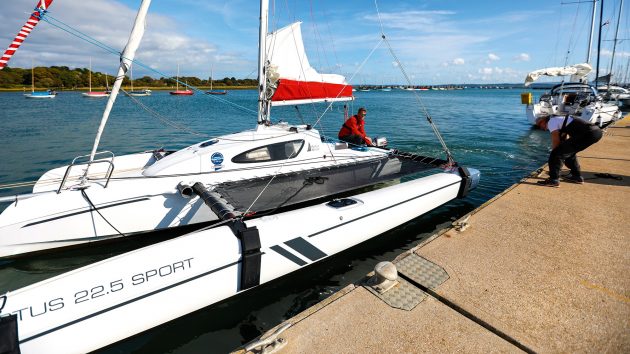
Steering with the outboard towards the pontoon will drive the stern in more; steer away to drive the bow in more
Offshore wind
Coming onto the pontoon with wind blowing off, it worked well coming in stern first. If there’s a tide running, you’ll want to be heading into the tide, so find a spot down wind and down tide to start your approach so you come in at an angle.
On our first attempt we had a bit of tide under us to start with so we came in at a much steeper angle, almost 90º, although this worked out OK in the end.
The crew could then step ashore, taking a line from the stern quarter round a cleat.
Drive forwards against the line and the bow will obediently drive up towards the pontoon, bringing you flat alongside. Getting off was simple, releasing the bowline, and allowing the bow to swing out the before slipping the stern line.
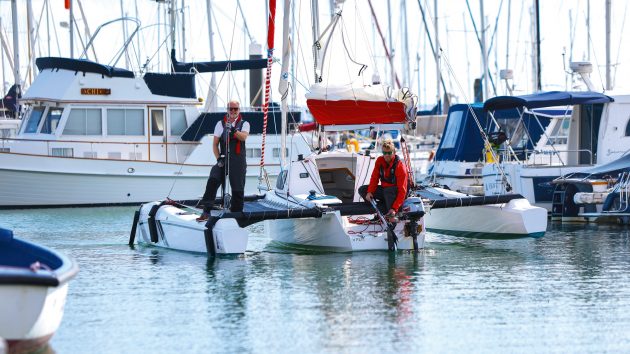
Coming in astern and stopping upwind of the berth meant the bows blew towards the pontoon far to quickly
Onshore wind
Getting onto and off a pontoon with onshore wind proved rather trickier. On our first attempt we came in stern first. The issue was that once we were just upwind of our desired berth and stopped, we lost steerage and the bow immediately blew off with alarming speed towards the pontoon.
Going ahead would only increase the force of the impact, while going astern only increased the bow’s sideways drift. I managed to back out without smashing the bow, but only just, and ended up awkwardly stern to the wind with the bows pointing at the pontoon.
On our second attempt we came in bows first but having aimed at the berth, I had to motor the stern to leeward to stop the bow hitting, making for a rather forceful coming alongside.
On take three, I came in forwards and began ferry gliding towards the berth early, keeping the bows to windward of the stern. Being able to steer with the outboard meant I could go ahead to keep the bow up, and go astern with the engine pulling the stern down toward the pontoon. In this way, it was possible to come in pretty well controlled and parallel to the berth.
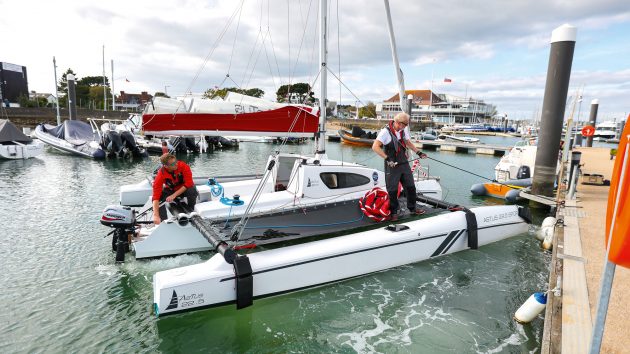
To get out, motoring astern against a bow line pulled the entire boat clear before slipping the line
Leaving was a different proposition all together, as I didn’t want to drag the bow along the pontoon, or to drive hard onto it to spring off. Instead, we rigged a slip-line from the forward cross beam. Going astern against this, and then turning the engine towards the wind, I could pull the stern, and the rest of the boat, out and away from the pontoon.
Keeping power on astern, once we’d reached a decent angle, we slipped the line and went astern, finding steerage way almost at once, with the bow following obediently in our wake with more control than I had anticipated.
Whether the wind is blowing onto, or off the pontoon, you want the engine to be driving or pulling the boat off the pontoon with a line on the corner you are going away from. That way you avoid point-loading fine ends where it’s hard to fender.
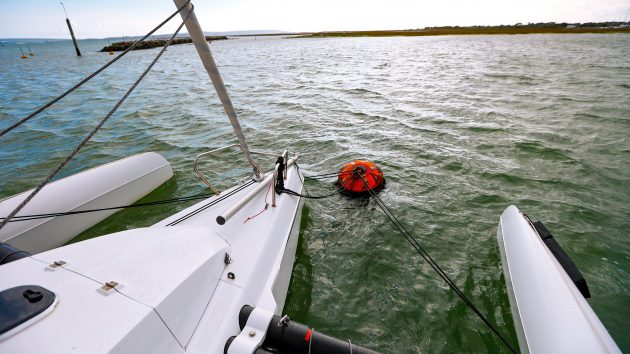
You’ll want a bridle to reduce swinging, but keep the pick up lines on the bow as backup
Anchoring and mooring a trimaran
While mooring a catamaran is complicated by the lack of a central bow, things should be simpler on a trimaran, and they are, mostly. Picking up a mooring buoy from the main hull bow with a low freeboard and dropping the pick-up line onto a cleat is easier even than a monohull.
The bow may be narrow, but for any lines that pass through a ring on the buoy, you still need to take it back to the same cleat to avoid chafe. That should be it, but windage from the two extra bows and the lack of keel mean the boat can dance merrily around the mooring buoy in a breeze.
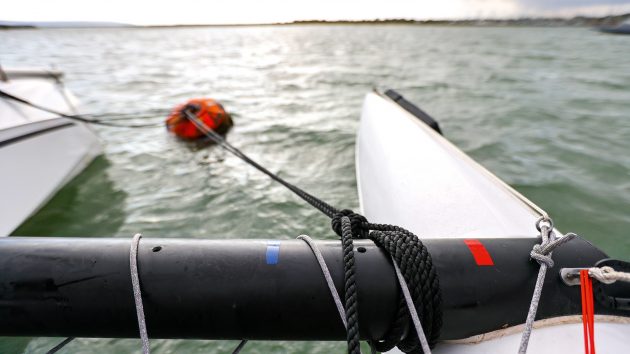
Rig the bridle so the buoy sits to one side to stabilise the boat
In practice, we found that a trimaran benefits from a mooring bridle in the same way that a catamaran does. It can’t be rigged from the floats’ bows, as there are no mooring cleats, so a line passed around the outboard ends of the forward beams gave a pretty good angle, again with long lines passed through the mooring and back to the same side. The main pick-up lines stay as a safety backup.
The other trick is to rig the bridle asymmetrically so that the buoy sits to one side or the other, just enough to not be dead head to wind, making it much more stable in the wind.
On the plus side, the lack of draught or keel means that you’ll nearly always be lying head to wind, so the cockpit remains nice and sheltered whatever the tide’s doing.
We ran out of time on the day to try anchoring, but rigging a bridle, effectively a long snubber to a point on the anchor chain in a similar way wouldn’t be tricky.
If you needed not to swing, or to behave more like deeper boats nearby, hanging a bucket over the stern can help, or there’s always anchoring with a kedge, either out ahead in a V, or in line astern.
Enjoyed reading this?
A subscription to Yachting Monthly magazine costs around 40% less than the cover price .
Print and digital editions are available through Magazines Direct – where you can also find the latest deals .
YM is packed with information to help you get the most from your time on the water.
- Take your seamanship to the next level with tips, advice and skills from our experts
- Impartial in-depth reviews of the latest yachts and equipment
- Cruising guides to help you reach those dream destinations
Follow us on Facebook , Twitter and Instagram.
Log in or Sign up
You are using an out of date browser. It may not display this or other websites correctly. You should upgrade or use an alternative browser .

Ninja Spider trimaran ceases production tooling on sale
Discussion in ' Multihulls ' started by Corley , Mar 8, 2014 .
Corley epoxy coated
I just noted on smalltrimarans.com the other day that the Ninja Spider trimaran has ceased production. They now have the rights to build, tooling and two of the boats up for sale. It makes you reflect on what market segment this boat was attempting to break into. The weta has been quite successful but I believe the key to it's success is the support that the manufacturer gives to events and races and engaging owners in activities and "in the loop". A similar approach saw the hobie 16 achieve great success and is I believe the key to growing a class. It's not really good enough to release a boat onto the market and just expect it to succeed. Often the problem seems to be after the tooling is completed there is not much money left in the bank for anything else. http://smalltrimarans.com/blog/?p=11210 and SMG's last video of the Ninja Spider trimaran: https://www.youtube.com/watch?v=Ox_mPc_A7xE
Doug Lord Flight Ready
Spider Thats a shame for the people involved. I can't help but think if the design had been innovative enough to use ama foils or designed to fly the main hull that it might have been a different story. Your point about marketing a lifestyle and not just a boat was something Hobie taught all of us years ago. Seemed like a lot of work to assemble-maybe a folding system that took 2 minutes to be ready would have helped. Seems like "just another trimaran" ain't going to cut it. This is the kind of quote that I hate to see from a manufacturer who must not realize the role foils play in modern trimarans. Seems like they were trying to make it something it wasn't: The Ninja got its sexy design inspired from the big modern Multihulls and it will surely be acclaimed in equal measure.
Attached Files:
Ninja-spider-trimaran-side-view-300x146.jpg, ninja-spider-trimaran-top-view-262x300.jpg.
Blackburn Senior Member
^^^ Thanks for posting, Corley! I'd not heard of this little design before. It is charming on flat water, but in the video all three hulls are in water, all too much. That's a drawback with little trimarans. It's not so easy, repeating something like the Hobie production run. Now that multihulls and beachcat designs have proliferated so much there'll probably never be another class that grows to that size.
Blackburn said: ↑ ^^^ Thanks for posting, Corley! I'd not heard of this little design before. It is charming on flat water, but in the video all three hulls are in water, all too much. That's a drawback with little trimarans. It's not so easy, repeating something like the Hobie production run. Now that multihulls and beachcat designs have proliferated so much there'll probably never be another class that grows to that size. Click to expand...
^^^ Allow me to state that a little more accurately. "That's a drawback with little trimarans, until such time as someone unknown demonstrates that they can in fact be levitated." Better?
All I'm getting at is that the perception of the masses is still that small trimarans are slow compared to beach cats. And it's a bad rap for trimaran design when there is such untapped potential...All I know about Levitation is that it is a 13th Floor Elevators song?!
Skyak Senior Member
Doug Lord said: ↑ All I'm getting at is that the perception of the masses is still that small trimarans are slow compared to beach cats. And it's a bad rap for trimaran design when there is such untapped potential...All I know about Levitation is that it is a 13th Floor Elevators song?! Click to expand...
It looks like SMG multihull are still producing the Ninja proa/outrigger and a large cruising cat. http://www.sail-the-difference.com/index.php?id=2
Corley said: ↑ It looks like SMG multihull are still producing the Ninja proa/outrigger and a large cruising cat. http://www.sail-the-difference.com/index.php?id=2 Click to expand...
- Advertisement:
Skyak said: ↑ I think the big misconception here is that speed or performance on the water has so much to do with the success or failure of a new, small, one product company. . Click to expand...
Ninja Outrigger/trimaran
Holy flipping ninja's batman..
- No, create an account now.
- Yes, my password is:
- Forgot your password?

Free Shipping in the US on Orders $75+

Item added to your cart
The complete list of trimarans.
There is no single trimaran that is best for everyone. Where some prefer luxury cruisers for long trips with family and friends, others might opt for a high performance racing tri for thrilling rides at breakneck speeds. With the recent spike in trimaran popularity, these days there is a perfect tri for every sailor. So to help prospective trimaran owners decide which boat is just right for them, we here at WindRider have put together a comprehensive list of the best trimarans on the market today! Read through for simple at-a-glance trimaran comparisons of boats both big and small, exhilarating and relaxing, and for all price points.
Jump to a specific sailing trimaran: Neel Weta Corsair WindRider Dragonfly Catri Astus Hobie Sea Pearl Farrier Sea Cart Multi 23 Triak SeaRail Warren Lightcraft Diam Radikal Challenger

Known for their award-winning luxury trimarans, NEEL is based in La Rochelle, the capital city of sailing in France. NEEL trimarans are built for fast cruising with an average cruising speed of about 10 knots, and are even configured to facilitate that sustained speed under motor propulsion. The NEEL 45 was notably named Cruising World’s Most Innovative Vessel in 2013, and by all accounts is an easy-to-sail, high performance boat that is just plain fun.
At a glance:
Models: NEEL 45, 65
Length: 45’ – 65’
Cost: $$$$$
Use: Luxury cruiser

A fan favorite, Weta trimarans are fast, stable, and remarkably easy to rig. This single-sailor tri has a capacity of up to three, and the ease with which it can be transported and stored makes this a great, versatile boat for beginners. The Weta was named Sailing World’s 2010 Boat of the Year, and one ride is enough to know why: simply put, the Weta is an absolute ton of fun to sail regardless of skill level.
Models: Weta
Length: 14’5”
Cost: $$ $$$

The high-end Corsair trimaran definitely holds its own in the categories of versatility, performance, and convenience. Boasting a rigging time of 30 minutes from trailer to sailor , the Corsair 42 – whose convenient folding amas makes trailering possible – is a simple option even for single sailors, though cabin space is suitable for two adults. These boats are wicked fast, capable of reaching speeds of 20+ knots, and were made for skilled sailors seeking solid construction and high performance vessels, not for beginners.
Models: Pulse 600, Sprint 750 MKII, Dash 750 MKII, Corsair 28, Cruze 970, Corsair 37, Corsair 42
Length: 19’8” – 37’
Cost: $$$$ $
Use: Sports cruisers

Built for the sailor who wants to maximize the joys of sailing while minimizing any hassle, WindRider trimarans are notoriously fast, very safe, and a blast to sail from start to finish. With several models that can hold between 1 and 6 riders, including adaptive designs to allow participation from sailors of all levels of mobility, there’s something to suit every sailor’s needs. The WindRider 17, an exhilarating ride perfect for families or camper sailors, has been known to reach speeds of up to 20mph. This easy day sailor goes from trailer to sailing in under 30 minutes and is sure to fit in perfectly with whatever adventures you have planned.
Models: WR 16, 17, Tango, Rave V
Length: 10’11” – 18’3”
Cost: $ $$$$
Use: Day sailor

The Danish-built Dragonfly trimarans come in a variety of models ranging from 25’ – 35’, all known for their spry performance, comfortable ride, and ease of use. Every model comes equipped with the unique “SwingWing” feature, a motorized system that can unfold the amas even while the boat is already underway – making it accessible to marinas and slips, and even makes trailering possible. Perfect for those who don’t want to sacrifice their comfort for high performance, the Dragonfly can breeze along at 13 knots while remaining one of the quietest compact cruisers out there.
Models: Dragonfly 25, 28, 32, 35, 1200
Length: 25’ – 39’

Designed for both safe cruising as well as for high speed racing, Catri trimarans will make your day. Especially noteworthy is the Catri 25, a stable yet wildly fast foiling trimaran with accommodations for up to 6 people. With profiles optimized for speeds of 25+ knots when foiling, this is no beginner’s sailboat. The special attention paid to stability in the foil design allows the Catri to be a single sailor vessel, even at foiling speed, with no special physical abilities. Whether you’re taking a small crew for longer rides at shuddering speeds or bringing the whole family along for a shorter, but still thrilling sail, the Catri is truly one of a kind.
Models: Catri 25
Length: 25’
Use: Cruiser/racer

A popular brand of trimaran in Europe, Astus has recently made its way to the US market to the delight of sailors on this side of the pond. Designed to offer maximum pleasure with minimum hassle, all models of Astus trimarans are fast to set up, quick on the water, inherently stable, and always a joy to sail. Their outriggers are mounted on telescopic tubes for easy stowage and towing, and can even be extended and retracted on the water for access to narrow passageways and monohull slips in marinas. With models in all sizes and price points, Astus trimarans are a great option for any sailor.
Models: Astus 16.5, 18.2, 20.2, 22, 24
Cabin: Some models
Length: 16’ – 24’
Use: Sport cruisers
HOBIE ADVENTURE ISLAND

Great for beginners and adventurers alike, the Hobie Mirage Adventure Island series is nothing if not just plain fun. With the option to use as a kayak or as a very basic trimaran, the Hobie is transportable, versatile, unintimidating, lightweight, and wonderfully affordable. The pedal system known as “Mirage Drive” allows a person to pedal the kayak using their legs for an extra kick of movement in slow winds. Amas tuck close to the main hull for docking or car-topping, adding serious ease and convenience to the exhilarating experience of the Hobie.
Models: Hobie Mirage Adventure Island, Mirage Tandem Island
Length: 16’7” – 18’6”
Use: Convertible kayak/trimarans

Best known for its use in camp cruising excursions, the Sea Pearl offers a roomy main hull and particular ability to sail in very shallow waters, making beaching and launching a breeze. The lightweight Sea Pearl trimaran is easy to tow, and the larger-than-expected cabin opens this vessel up for overnight adventures with plenty of storage space. The simple design makes the Sea Pearl notoriously low maintenance, and the ease it takes to rig and sail it add to the overall delight of owning this boat.
Models: Sea Pearl
Length: 21’
Use: Camper cruiser

Quick, lightweight, roomy, and trailerable, Farrier trimarans are made for versatility to fit every sailor’s needs. Different Farrier models are available in plan or kit boat form for those who appreciate building their boat themselves, but of course, also as the full production sail-away boat for the rest of us. Single-handed rigging and launching takes under 10 minutes from start to finish, minimizing hassle and getting you on the water fast. All non-racing Farrier designs use a minimum wind capsize speed of 30 knots or more to ensure safety for all those aboard. Add the roomy cabin and high speed capabilities to the equation and you’ve got a boat that is great fun for everyone.
Models: F-22, 24, 25, 82, 27, 28, 31, 9A, 9AX, 9R, 32, 33, 33R, 33ST, 36, 39, 41, 44R
Length: 23’ – 39’4”
Cost: $$$ $$
Use: Sport cruisers/racers

One of the biggest names in the game, SeaCart is internationally noted for its high performance trimarans that far exceed expectations for a production boat of its size. The SeaCart trimaran performs as brilliantly off the water as it does on with its super-light and efficient harbor folding system, making light work of trailering. Notoriously easy to manage and maintain, the SeaCart 26 One Design is the ultimate day racing trimaran, designed for both course and inshore/coastal distance racing. Absolutely worth the international buzz it has garnered, the SeaCart is a thrill from beginning to end.
Models: SeaCart 26
Length: 26’

A high performance racer class, the Multi 23 is a lightweight, powerful trimaran known for its wicked speed of up to 25 knots. Multi trimarans of both available configurations were designed to give beach cat thrills and speed without any of the stability or seaworthy concerns. Open ocean sailing is no issue for the Multi’s big bows, which do their job to keep her stable. Built for sailors with a need for speed, the Multi makes a perfect weekend boat for racers, especially those with a taste for boat camping.
Models: Multi 23
Length: 23’

Another dual outrigger sailing kayak/canoe design, the Triak trimaran was designed to be effortless and fun, especially for beginners. Paddle the kayak with sails furled, use the foot pedals for an extra kick of momentum, or sail with just the mainsail – the only boat in its class to feature an asymmetrical spinnaker – for exhilarating speeds and a blast on the water. Car-top the Triak anywhere for a quick sail or plan for a week long expedition, but always count on having a great time on this easy little boat.
Models: Triak
Length: 18’
Use: Convertible kayak/trimaran

SeaRail trimarans are known for being affordable, light weight, trailerable trimarans that offer the perfect combination of exciting and relaxing experiences to a wide range of sailors. Whether it’s day sailing with your family, resort or camper sailing, SeaRail trimarans are ideal leisure vessels. Leave the hassle to the other boats – the SeaRail takes you from trailer to sailor in 15 minutes. But don’t let its reputation as a leisure tri fool you: if speed is what you want, rest assured that the SeaRail can deliver that as well.
Models: SeaRail 19
WARREN LIGHTCRAFT

Warren Lightcraft trimarans , another example of a convertible kayak-to-sailboat option, are known for their aesthetically pleasing designs that are also, as the name implies, very light for simple transportation and ease of use. Convert the kayak into a fast, high performance sailboat in just minutes, fly around on the waves all day long, then simply car-top the 68lb Warren for a maximum enjoyment, low-hassle day on the water. Perfect for sailors and paddlers of all skill levels, the Warren Lightcraft is the best of both worlds and an absolute joy to sail.
Models: Warren Lightcraft
Length: 15’6”

Built strictly with racing in mind, the Diam 24 is a light, powerful one-design class trimaran and a notoriously exceptional performer. Boasting blistering speeds of up to 30 knots, Diam trimarans are not intended for beginners. For racers who crave the very best in terms of intense speeds, smooth handling and impeccable performance, the Diam is the red-hot one-design racing tri for you.
Models: Diam 24
Length: 24’

For the sailor who prefers the finer things in life, the Radikal 26 delivers. Perfect for bringing the whole family out for a day on the water, this high performance, trailerable sailing trimaran strikes the most luxurious balance between quicksilver speeds and a smooth, comfortable ride. The Radikal 26 trimaran is as convenient to transport and set up as it is pleasant to sail, with a folding system that minimizes rigging hassle and also makes this a trailerable tri. Built for a fast and comfortable sail rather than a hold-onto-your-seats thrill, one-the-water safety and overall pleasure makes the Radikal 26 what it is.
Models: Radikal 26
Use: Sport cruiser

A solidly-built, single-handed trimaran, the Challenger also doubles as an adaptive design – meaning it is made to accommodate sailors of all levels of physical mobility. Best suited to lakes, the Challenger is a very safe, seaworthy boat for sailors of all ages and experience levels. Add to this the ease of owning, transporting and maintaining the Challenger trimaran and what you get is a simple, fun sailboat perfect both for beginners and those seeking a cheap thrill alike.
Models: Challenger
At a glance comparison:
| Astus 16.5, 18.2, 20.2, 22, 24 | 16’ – 24’ | Sport cruiser | Some models | ||
| Catri 25 | 25’ | Cruiser/racer | Y | ||
| Challenger | - | Day sailor | N | ||
| Pulse 600, Sprint 750 MKII, Dash 750 MKII, Cruze 970, Corsair 28, 37, 42 | 19’8” – 37’ | Sport cruisers | Y | ||
| Diam 24 | 24’ | Racer | N | ||
| Dragonfly 25, 28, 32, 35, 1200 | 25’ – 39’ | Luxury cruiser | Y | ||
| F-22, 24, 25, 82, 27, 28, 31, 9A, 9AX, 9R, 32, 33, 33R, 33ST, 36, 39, 41, 44R | 23’ – 39’ 4” | Sport cruisers/racers | Y | ||
| Mirage Island, Mirage Tandem Island | 16’7” – 18’6” | Convertible kayak/trimarans | N | ||
| Multi 23 | 22’ | Racer | Y | ||
| NEEL 45, 65 | 44’ – 65’ | Luxury cruiser | Y | ||
| Radikal 26 | 26’ | Sport cruiser | Y | ||
| Sea Pearl | 21’ | Camper cruiser | Y | ||
| SeaCart 26 | 26’ | Racer | Y | ||
| SeaRail 19 | 18’ | Day sailor | N | ||
| Triak | 18’ | Convertible kayak/trimaran | N | ||
| Warren Lightcraft | 15’6” | Convertible kayak/trimaran | N | ||
| Weta | 14’5” | Racer | N | ||
| WR 16, 17, Tango, Rave V | 10’11” – 18’3” | Day sailor | N |
Did we miss one? Let us know. Tell us what you sail and what you like about each boat in the comments below.
- Choosing a selection results in a full page refresh.
- Opens in a new window.
- Petites annonces
- Dernier magazine
- Fiches techniques
- Mentions légales
- Plan du site
TRIMARAN NINJA 8 VENDU
- +33 6 88 09 46 68
- www.multicoquesconsulting.com
- Visible à LE HAVRE, France
Infos pratiques
- La fiche technique
- Essai : Ninja 8
- Financez votre Ninja 8
- Assurez votre Ninja 8

Description
« One of the best tris I’ve ever sailed » : ce sont les mots de son constructeur, Darren Newton, connu pour ses constructions minutieuses de multicoques de course (nombreux multicoques inscrits à l’OSTAR). Le Ninja 8 est un trimaran « one off » haut de gamme réalisé par le chantier DAZCAT de Millbrook en 1997 avec une finition superbe. Ce chantier est spécialisé dans la production de multicoques et de bateaux de course. L’habitabilité exceptionnelle de la coque centrale, sa généreuse largeur au-dessus de la flottaison, correspond parfaitement à son programme : la course-croisière côtière avec tout le confort pour deux ou trois personnes, mais il permet le couchage pour 5 personnes. Le bateau est en excellente condition avec un entretien régulier et soigné, ainsi que des mises à niveau constantes. Designer: Jean Louis LIGONNET Architect: Gérard CHENUS Builder: Darren NEWTON Shipyard: DAZCAT Year built: 1997 Flag of registry: France Length o.a.: 8,65 m Water length: 7,95 m Beam o.a.: 6,60 m Drought min. – max.: 0,45 – 1,40 m Air draught: 13 m Displacement: 1 300 kg (weighed in September 2020) Conception Sandwich composite hulls under vacuum: 420 g biaxial glass fibre/polyester & Airex foam, local reinforcements with carbon fabrics in strain areas such as the central crossbeam, daggerboards and rudders. Main hull: Crash box and waterproof volume in the forward cabin, composite frame under the roof (reinforcement of the foot of the mast), monolithic area under the deck in the forward cabin (reinforcement of the central crossbeam) Amas: Crash box and waterproof volume in front of the fasteners of the central crossbeam, watertight bulkhead in front of the daggerboards casings and demountable partition in front of the rudders, monolithic zones under the deck with darning of fibre composite laminates on the shell plating (reinforcement of the crossbeams), daggerboard casings in composite sandwich, laminated on the hull bottom and on the deck, inside carbon reinforcements at the fasteners of the rudders, Lewmar hatches for storage access. Antifouling coppercoat (2017) Self-draining cockpit with open sugar scoop Carbon fibre rotating wing mast with ball and socket joint, one pair of spreaders Carbon fibre boom with rotating arm Curved central crossbeam in carbon composite Straight rear crossbeam in anodised aluminium alloy Asymmetric daggerboards, implemented in the amas, operated from the cockpit Two shaped composite rudder blades, sliding into castings Three helms: amas (hand steering gear with stanchions, back supports and compass) and cockpit (stick) Anchoring: Spade A80 with 5 m mooring chain 10 mm + 35 m leaded rope 12 mm Trampolines (sewing 2020), safety nets (2020) Manual bilge pump Through hull echo sounder and speedo Deck equipment 2 MEISSNER 21ST-32 deck Winches and 1 MEISSNER 23ST-41 winch in the cockpit (cleaned and lubricated in 2020) 8 LEWMAR rope clutches (deck and mast), blocks RONSTAN/HARKEN 2 stainless steel mooring cleats rétractables on the amas and 2 stainless steel cleats at the bow Aluminium bowsprit with NEX 1.5 Furlassist Cockpit compass 2 Helm compasses Silva 85 Magnetic North Draped cable life lines on both sides of the main hull Sails Carbon membrane full-batten gaff main sail with 3 reefs (UK Sails 2008) Kevlar membrane PROFURL furling headsail (UK Sails 2008) Code 0 (44 m2) « Dimension Polyant » (Incidence 2020) Asymmetricalspinnaker (71 m2) « Nylon croisière Coupe Tri-radiale » (Incidence 2020) Symmetrical Nylon spinnaker (79 m2) Lazy bag, jib sleeve (2020 et 2018) Electronics B&G Vulcan XSE7 chartplotter Navionics 46XG mapping 2 B&G Triton 2 cockpit digital display VHF AIS Radio Ocean RO6800 FURUNO GPS Navigator EPIRB Ocean Signal E100 Comfort Bedding for 3/5 persons: front double berth (with deck hatch) 2,05 x 1,55/0,60, 2 king-size saloon berth, 1 rear berth under cockpit 1,95 x 0,70 Headroom (galley, navigation): 1,95 Sunbrella washable cotton upholstery (2018) 2-burner gas stove SMEV (outdoor gas cylinder, indoor shutoff valve), stainless steel kitchen sink (50 L water tank) with electric water pump, coll space under the saloon table Electricity: Solbian 64 W flexible solar panel (2018), Western Marine regulator, 12 V Stormline 115 Ahbattery (2018), 4 Led spotlights, navigation lights at the masthead, 3 USB ports Jabsco manual marine toilets Engine Yamaha 8 HP 2 stroke long shaft outboard (exhaust pipe and all gaskets including cylinder head 2019) Wooden motor bracket, articulated, on travelling rails fixed on the bottom of the cockpit with stainless steel axes lock (the engine slides under the floor of the cockpit for weight centering) Offshore security: EU category C Autobraking road trailer (Ninja is transportable disassembled)
Informations
Motorisation, gréement et voiles, aménagement, electronique, contacter l'annonceur.
Partagez cette annonce
Petites annonces similaires.

TRIMARAN REPLIABLE MATTIA T 11 (vente suspendue)

TRIMARAN IRENS 40

NEEL TRIMARANS 52, livraison possible mai 2025

NEEL 45 disponible sud France

DRAGONFLY 920 EXTREME
TRIMARAN FOILER EX TRINITRINE

FREELY EVOLUTION (construction amateur sur base Freely) VENDU/SOLD

TRIMARAN A CAPELLA 40'

TRIMARAN MULTI 23
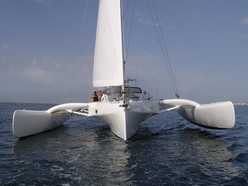
TRIMARAN POLYNESIE 42'
Ajout au favoris.
Vous avez ajouté " " à vos favoris.
Vous avez supprimé " " de vos favoris.
Tout Trimarans
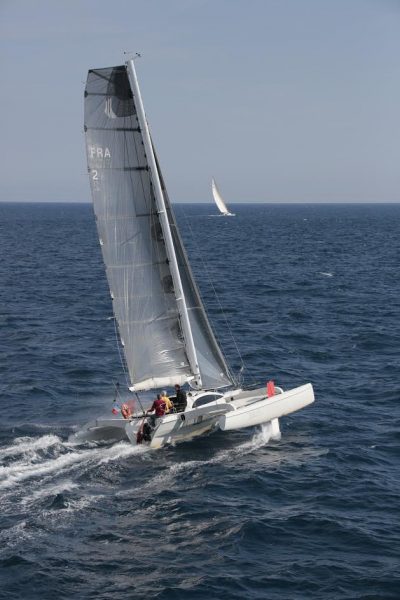
TRIMARAN CABON 40′ (vendu)
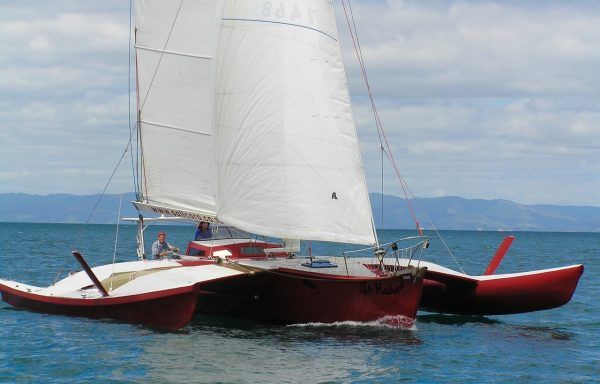
NEWICK 53′ LIMMERSHIN
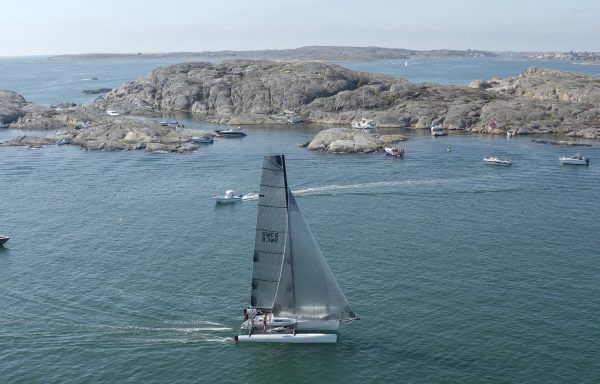
SEACART 30′ (VENDU)
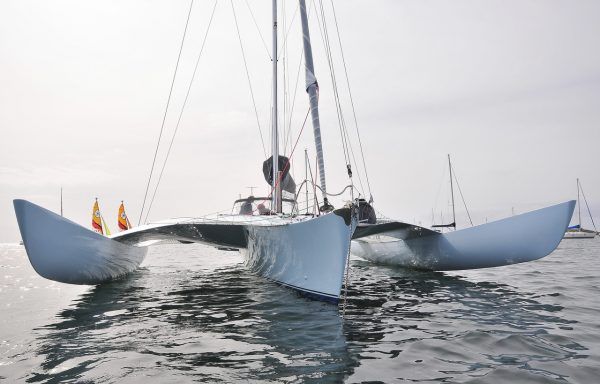
NEWICK THREE CHEERS MKIV evolution (offres requises-offers studied)
- « Page précédente
- Page suivante »
- 0 No item in your cart
- The magazine
Current issue
- All the issues
- My magazines
- Technical specifications
- Multihull of the Year
- Classified Ads
- Destinations
- Online store
- All the magazines
- Subscriptions
- Accessories

Dragonfly 800
Following a career spanning two decades and with 400 units built, the Dragonfly 800 - DF800 for the connoisseurs - is certainly one of the most remarkable successes in the category of small transportable trimarans. Nearly 40 years after it was launched, this model remains a very attractive proposition!
Practical info
- Builder : DRAGONFLY /QUORNING BOATS
- Finance your Dragonfly 800
- Available in issue # 181
Boat Test price 3.00 € Inc. tax

Add several tests to your cart
and get an extra discount!
With its coachroof that covers the full width of its central hull, the Dragonfly 800 sticks to a recipe from many famous monohulls, including the Corsair or the Catalina 22. The only difference is that while the overall living space offered corresponds to that of a monohull of 6 or 7 feet shorter, the trampolines offer much easier circulation on deck - not to mention space for lazing around! The general design of the DF800 is very eighties-style, which is to be expected, given that it was launched back in 1984. The deck is perfectly horizontal, with a colored band around the windows and the coachroof, maintaining the look of many monohulls of the period, and the transoms are inverted and rounded. Below the waterline, the hulls are narrow, and the appendages can be raised up. The Dragonfly 800 continued its long and brilliant career under various versions: the MK1 then MK2 came with fixed linking arms, though these are still removable for transport and storage. In 1989, the Danish shipyard Quorning Boats launched the Swing Wing. This latter version, built in 143 examples, adopts the famous folding arms that are so practical for limiting your beam in port.
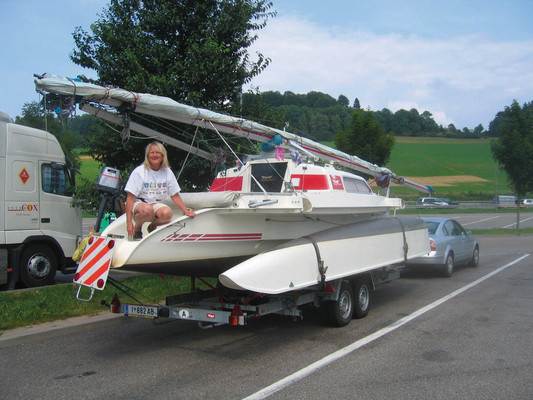
To read in full, Buy the boat test
Tags :
- Dragonfly 800 ,
- Quorning Boats
What readers think
Post a comment
No comments to show.
Useful links
MW #197 - Oct / Nov 2024
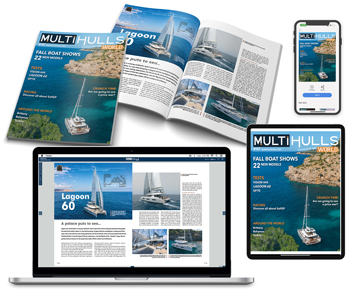
Download all the Boat Tests
Over 500 multihull tests
Boat tests from the same builder
- Dragonfly 40

- Dragonfly 1000

- Dragonfly 1200

- Dragonfly 32 Evolution
Place a classified ad Free of charge
on Multihulls World
Boat tests from the same range

MiniCat Guppy
- Minicat Guppy

- Tricat 25 Evolution

- Aventura 28
Classified ads
2020 Fountaine Pajot MY6 (ex MY44)

Solid and fast catamaran
Catamaran Lagoon 470 et sa société de commercialisation

Woods Flica 35
Vous avez ajouté " " à vos favoris., vous avez supprimé " " de vos favoris., in order to add this article to your favorites, please sign in..
Ninja Spider Trimaran Capsize Test & Sailing Videos
by Small Tri Guy | Apr 11, 2011 | Production/Commercial Small Trimarans , Small Tri Info - All , Small Trimaran Videos | 5 comments
In our first post about the NINJA SPIDER TRIMARAN , we found this sailboat being offered in 3 different production variations. The first option, referred to at the time as the “NINJA SPIDER resort,” has been removed from the updated SMG-Multihull pricelist so things could be simplified.
The designer, Gerhard Schein, provided some updated photos of this boat, which display it during a recent “capsize test.” This is an surely an important subject when it comes to smallish beach trimarans.
Gerhard offers the following update below, in addition to the photos and a few YouTube links.
……………
The basic NINJA SPIDER TRIMARAN model in our line is now the Spider ECO, with all fitted equipment incl. bowsprit, but delivered only with mainsail. (see new price list)
The NINJA SPIDER R is now the full equipped Spider, with three sails and roller furler. We’ve removed the “Magic box” as standard equipment, however, because we saw that not everybody wanted the box. The Ninja Spider tri fits on a roof rack from a middle class car.
Both models are the same. Only the sail sets are different. A crew of two can easily sail the three sails.
The NINJA Spider is designed as a fast, but safe singlehanded sports multihull. In light wind condition it’s not a big challenge to sail solo with tree sails. The cockpit is designed for that. In condition 3-4bft it’s nice to sail only with the main upwind and downwind together with the screecher.
We did a capsize test last time cause so many people were asking for it! It was not so easy to capsize the trimaran. I sailed quite a while with my crew on the leeward outrigger. The water surface was on the knees and we didn’t capsize!
Ninja Spider Trimaran Capsize Test
We had to pull the shrouds to leeward to capsize the boat. And – it capsized about the stern (see pics)!
Then we opened the capsize hatch on one outrigger stern to float the hull, and to press it with the crew weight under water. After turning the boat it easily started sailing again and the outrigger emptied itself. After a while you can close the hatch and enjoy sailing again.
For more about the Ninja, visit SMG Multihull at Sail-the-Difference.com . Finally, here are the new NINJA SPIDER TRIMARAN videos on YouTube…
For more about the Ninja, visit SMG Multihull at Sail-the-Difference.com
Hi.. I built a small ply tri.. After a few capsizes I decided to fill the amas with empty plastic bottles and the rest with PU foam because the water once in, could not get out and I’d rather go for 7 more kgs than for 70 more when water filled the ama volume ( one ama roughly 70 liters).
How did you manage to make them self bailing ?
Hi Stefano, If you click on the last photo and look very closely at the back of the ama, you will see a screw cap/hatch that can open up to let water out. You probably could fit small cap-hatches on your ply amas in order to achieve the same thing.
It’s a bit hard to be sure from reading the text (due to what appears to be some kind of translation issue) but it appears that in the case of the Ninja tri, those inspection ports are being used to flood the ama as part of the recovery process, to overcome some of the righting moment that makes tris hard to turn back over once they’ve turned turtle-
“we opened the capsize hatch on one outrigger stern to float the hull, and to press it with the crew weight under water. ”
I may be wrong, but I think they meant to say “to sink the hull”…
it’s something Stefano and others might want to consider when deciding to install permanent flotation or to permanently seal the hulls- depending on the boat, you may want to maintain the ability to flood the amas at will for this kind of recovery procedure, especially with larger boats where crew weight alone may not be enough to flip the thing over.
The ability to partially sink an ama can also be an advantage if you need to raise the opposite ama in the event of a holing or to perform needed repairs, and also when doing certain diving and salvage/rescue type operations where you want to apply all that crossarm leverage to something like a stuck anchor or a disabled swimmer and don’t have enough crew weight to overcome the ama’s buoyancy.
Personally I’d be freaked out to just unscrew that type of inspection cover/cap kind of thing out on the water, especially when swimming in conditions that caused a capsize in the first place…at the very least I’d want some strong leashes to keep them with the boat.
And even then, I’d consider that setup to only be partially ‘self-bailing’ at best…true self bailing is pretty much a hands-off deal that uses either a strategically placed venturi style fitting that sucks water out via forward boat motion and seals water out at rest with a simple gasket/check valve (the “Elvstrom bailer” is the classic one), or uses spring loaded flaps that open with water pressure to allow water to flow out of the boat when swamped (the “transom flap”).
They are very common in racing dinghys (Lasers have a venturi fitting built in) and could be used not only to make small tri hulls truly self bailing, but also as part of a righting and recovery system/protocol by manually overriding the check valve aspect.
I think you’re understanding their procedure correctly Ian. And you additional info is great!
Old comments but worth putting my 2 cents worth in.
Weta has a similar recovery process as the spider, they unscrew the leash retained end cap and flood the float. Then it semi bails under suction caused through the wake trough once sailing again, you then close the end cap. It may not completely empty the hull but it seems to serve it purpose, not owning a Weta I am only going on vids from online.
On my little Bazooka there is only a small 10mm drainage bung at the front and on top of the hull. No way in the world you will flood that sufficiently in a decent time frame to assist with righting, let alone drain it again!
I have however come up with a work around if ever needed. The Bazooka AMA’s are quick release, so if turtled I simply release the AMA from one side and strap it to the other. It’s then simply a matter of righting which is easier than a cat to do and refitting the AMA. It only takes 2 clips and a couple of short retainer straps to effect the rescue. Have had to employ this technique only once so far in difficult conditions and was more than pleased with the results.
Would be a somewhat more difficult task on a larger design boat or one with lashed on or permanently fixed AMA’s. More so with a tri that has mast stays attached to the AMA’s. The Bazooka has a free standing foam filled carbon fibre mast so no stay wires or ropes to tangle up in.
For me in a small beach tri I think simplicity, fun and functionality trumps speed and complexity.
I truly believe that current small tri designs are scaring people away from sailing them. The Weta whilst an awesome design for more experienced sailing looks very complicated for a novice.
Meermark on the other hand with it’s simple sail and seating would appeal to novice sailors, as would the Bazooka if it where still being made.
The Ninja Spider I believe falls into the more experienced sailor category.
Hey Small Tri Guy why not do an article on small beach trimarans and their complexity vs performance vs skill level?
Submit a Comment
Your email address will not be published. Required fields are marked *
Notify me of followup comments via e-mail. You can also subscribe without commenting.
Blog Post Categories
- Production/Commercial Small Trimarans (291)
- Self-built Small Trimarans (678)
- Small Trimaran Audios (30)
- Small Trimaran Videos (289)
- Trimaran Design, Rigging, Construction Info/Links (222)
- Contact “Small Tri Guy”

IMAGES
COMMENTS
NINJA 8. Concepteur : Jean Louis LIGONNET. Architecte naval : Gérard CHENUS. Constructeur : Darren NEWTON. Chantier : DAZCAT. Année de construction : 1997
Ninja 8. England is known as the land of splendid automobiles with long hoods under which all their power and modernity is concealed. The island also has a glorious past in its shipyards, which build multihulls for a select few...This is true of the DAZCAT shipyard, which offers a very engaging "convertible" of the sea: Ninja 8...
TRIMARAN NINJA 800 (vendu) ... 118,000€ TRIMARAN PROTOTYPE 43′ 190,000€ trimaran NOVA (ex JOURNAL DE MICKEY/ ex CAPTAIN COOK) offres requises. TRIMARAN NIGEL IRENS 40′ (vendu-sold)
NINJAthe modern multifunctional sports multihull needs minimum store space and provides maximum sailing fun. Big advantage of the NINJA is that you have the possibility to have 2 multihulls in 1. First option is the NINJA SPIDER trimaran which is designed to be fast and easy to sail for 1 or 2 people. With the carbon mast disassembled in 2 ...
Water length: 7,95 m. Beam o.a.: 6,60 m. Drought min. - max.: 0,45 - 1,40 m. Air draught: 13 m. Displacement: 1 300 kg (weighed in September 2020) Conception. Sandwich composite hulls under vacuum: 420 g biaxial glass fibre/polyester & Airex foam, local reinforcements with carbon fabrics in strain areas such as the central crossbeam ...
TRIMARAN NINJA 8 Location : LE HAVRE, France Year : 1997 Asking 50 000, 00 Inc. tax€ A beautiful, recently overhauled, folding Dragonfly 800 trimaran with roadtrailer for sale in Spain. Location : chez Valence, Spain Year : 1991 Asking 38 500, 00 Inc. tax€ Place a classified ad Free of charge. on Multihulls World.
The Ninja SPIDER fits like the Ninja PRO in the practical box in the same dimensions of 4.7x0.80x0.85m. The trimaran can get upgraded to a proa (Upgrade: Proa beams und trampolines necessary) Ninja SPIDER is available equipped as: NINJA SPIDER resort Trimaran ready to sail, Dacron sails with jib on roller furler extra protected bow sections
The Ninja 8m is a fast production built trimaran, suitable for racing and or cruising. Below she has a surprising amount of space sleeping 5 in comfort with a small galley and a heads which is located neatly behind the companion way. Above decks she is an out and out speed machine with Carbon spars and high performance sail plan.
Trimaran sail trim. One of the biggest differences between a cruising monohull and a multihull is how the mainsail is trimmed. Leech tension on a yacht is often largely controlled by the kicker and the backstay, while the mainsheet sheets the mainsail in and out, predominantly controlling the angle of the boom to the centreline, and there may be a short traveller.
Trimaran sailing vessels for sale on YachtWorld are offered at an assortment of prices from $24,354 on the relatively more affordable end all the way up to $1,586,942 for the most luxurious model vessels. Find Trimaran boats for sale in your area & across the world on YachtWorld. Offering the best selection of boats to choose from.
TRIMARAN MULTI 23 Location : VANNES, France Year : 2012 20 000, 00 Inc. tax€ A beautiful, recently overhauled, folding Dragonfly 800 trimaran with roadtrailer for sale in Spain. Location : chez Valence, Spain Year : 1991 38 500, 00 Inc. tax€ NINJA 8 (SOLD) Location : LE HAVRE, France Year : 1997 50 000, 00 Inc. tax€ Woods Flica 35 ...
NINJA Trimaran Brochure Excerpts (in English) by Gerhard Schein. NINJA is the new generation of intelligent designed sports boats: fast, fun and sexy. At first glance it is noticeable that this multihull is fast and fun to sail. Top materials and an intelligent design ensure a high fun factor already in light wind conditions.
Seems like they were trying to make it something it wasn't: The Ninja got its sexy design inspired from the big modern Multihulls and it will surely be acclaimed in equal measure. Attached Files: ninja-spider-trimaran-side-view-300x146.jpg. File size: 4.7 KB. Views: 925. ninja-spider-trimaran-top-view-262x300.jpg.
These boats are wicked fast, capable of reaching speeds of 20+ knots, and were made for skilled sailors seeking solid construction and high performance vessels, not for beginners. At a glance: Models: Pulse 600, Sprint 750 MKII, Dash 750 MKII, Corsair 28, Cruze 970, Corsair 37, Corsair 42. Cabin: Yes.
First seatrial from the Ninja Spider Trimaran what you can also sail as a Proa. You have to change the beams and leave one outrigger at home:-)
The designer of the Dragonfly is Borge Quorning, a Dane who also builds them. The first boat was launched in 1981; the 800 Swing Wing is a third generation model, introduced in 1989. Construction is unidirectional fiberglass with Airex coring in the hull and deck. The glass work looks first-class with no ripples, clean edges, and many nice ...
TRIMARAN NINJA 800 (vendu) TRIMARAN NINJA 800 (vendu) Magnifique petite machine très polyvalente (régate-vitesse-croisière) sur les plans de Gérard Chenus. La construction par le chantier Multimarine de Darren Newton fait référence. L'habitabilité de la coque centrale est surprenante et permet la croisière 2+2 (avec enfants) ou à 3 ...
Le Ninja 8 est un trimaran « one off » haut de gamme réalisé par le chantier DAZCAT de Millbrook en 1997 avec une finition superbe. Ce chantier est spécialisé dans la production de multicoques et de bateaux de course. L'habitabilité exceptionnelle de la coque centrale, sa généreuse largeur au-dessus de la flottaison, correspond ...
Tout Trimarans. DRAGONFLY 28 PERFORMANCE (VENDU/SOLD) 216,000€ NEWICK THREE CHEERS MKIV evolution 310,000€ TRIMARAN NINJA 800 50,000€ ...
LENGTH: Traditionally, LOA (length over all) equaled hull length. Today, many builders use LOA to include rail overhangs, bowsprits, etc. and LOD (length on deck) for hull length. That said, LOA may still mean LOD if the builder is being honest and using accepted industry standards developed by groups like the ABYC (American Boat and Yacht Council).
Practical info. Builder : DRAGONFLY /QUORNING BOATS. Technical specifications. Finance your Dragonfly 800. Available in issue # 181. Boat Test price 3.00€ Inc. tax. Purchase. With its coachroof that covers the full width of its central hull, the Dragonfly 800 sticks to a recipe from many famous monohulls, including the Corsair or the Catalina 22.
Full test in Multihulls World #179:https://www.multihulls-world.com/review/trimaran/tricat-690-cruising-and/or-sport-as-you-like All first sea trials for ...
In our first post about the NINJA SPIDER TRIMARAN, we found this sailboat being offered in 3 different production variations.The first option, referred to at the time as the "NINJA SPIDER resort," has been removed from the updated SMG-Multihull pricelist so things could be simplified.. The designer, Gerhard Schein, provided some updated photos of this boat, which display it during a recent ...